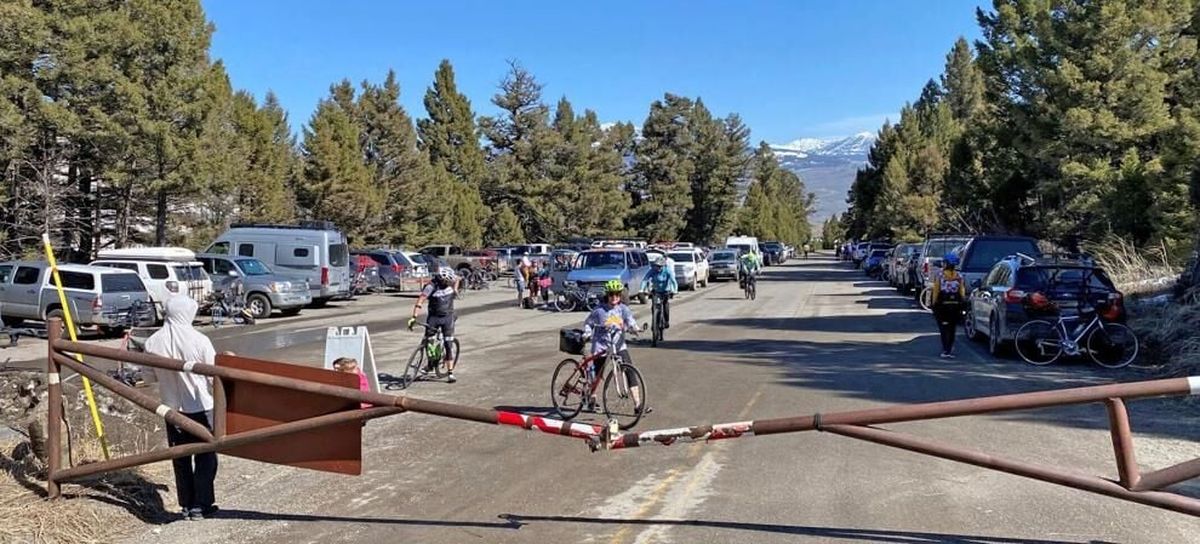Traditional cyclists encounter new Yellowstone travel companions

YELLOWSTONE NATIONAL PARK – Imagine the cyclist clad in brightly colored skin-tight shorts and top, helmeted head held low, legs pumping hard into the headwind as they pedal up a steep hill near Norris Geyser Basin.
Then, quietly humming past them comes a joker clad in a Hawaiian shirt pedaling an upright town cruiser bicycle. Ringing a handlebar mounted bell as they pass, the goofball shouts a greeting and waves.
Such scenarios may be more common these days, marking the end of an era of traditional cyclists dominating the spring ride into Yellowstone National Park. Now blazing onto the landscape are e-bikers of all shapes, sizes and ages. Technology has made it possible for the average rider to trek where once only the brave, bold and fit ventured.
Sun seekers
The weekend of April 13 was a prime example of the new epoch. Unlike most spring days when snow or sleet are likely as Yellowstone edges from freezer-cold to just frigid, this day saw temperatures in the 60s and cerulean skies.
The parking area at Upper Terrace Drive, above Mammoth Hot Springs, was strewn with cyclists assembling their gear. Some dressed for a festive ride, with a pink onesie and hand-sewn possum costume complete with rodent teeth, just a few of the many odd outfits.
Vehicles disgorging riders extended down the hillside. Other visitors parked at Mammoth and braved the switchback climb up to the gate that blocks vehicles for this temporary cycling season.
When the road between Mammoth and West Yellowstone is plowed clean of snow in spring, for a short time bicyclists are allowed to ride the route nearly vehicle-free, except for the occasional workers driving through.
We considered riding up from Gardiner along the new road constructed after the 2022 flood washed out the old Gardner River route. The replacement highway makes a serpentine climb above Slide Lake along a one-time stagecoach road. Turnouts provide an opportunity for grand views looking back toward the Absaroka Mountains and Gardiner Basin. But the possible drain on our bicycle’s battery power deterred us from the climb.
“Coming down is great, going up is tough,” warned Jay O’Connor, who guides e-bike tours into the park. “It will chew your battery up.”
Snow-free
It was 2013 when I made my first foray into Yellowstone for the April cycling season. All of the warnings about self-rescue, unpredictable weather and the possibility of bear or bison encounters had me on edge, not to mention the 100-mile round trip. That’s the farthest I’ve pushed my cycling muscles, and then only three times. Two other years we went only one way, or waited until the road was open to vehicles and used that to shorten the distance.
In all of those years, the weather has been cool, which is to be expected at elevations ranging from 5,500 to 7,500 feet. We’ve pedaled through snow, rain, sleet and wind, numbing conditions for cycling.
This time, the weather was unbelievably balmy. Cyclists flocked to Yellowstone’s North Entrance. Coats and mittens could be abandoned in the car. Sunscreen was more important.
Animals were few, with most elk and pronghorn congregating closer to Gardiner and bison just beginning to trek toward Swan Lake Flat after lounging on the green lawns of Mammoth.
E-biking surge
It’s a guess, but maybe one-quarter of the cyclists were on an e-bike as we ventured from the locked gate to the Norris Geyser Basin overlook. Pedaling into a headwind with an elevation gain of about 1,200 feet we covered the 17 miles quickly, stopping over at Roaring Mountain on the way in to sunbathe, watch the ravens and snarf down sandwiches.
On the way back, we were lucky enough to talk our friend into shuttling the vehicle back to Gardiner so two of us could ride the winding switchbacks downhill. The route drops about 1,100 feet in 6 miles.
The replacement road from Mammoth to Gardiner features a 10% drop with some hairpin turns, which is a lot of fun on a bike, but not when you are pulling a loaded snowmobile trailer in icy conditions.
The Park Service is considering building a new North Entrance road. If a different route is chosen, the temporary road could be open to bikers and hikers. Then Yellowstone visitors would have another year-round paved route free of vehicles.
Envy or anger
O’Connor said although he’s been in the e-bike tour business for four years, he still gets yelled at by traditional cyclists who call him a “cheater.” He said on occasion the offended cyclists have come close to throwing punches.
He told those insulted by his mechanical assistant: Just wait, someday your knees or hips will be in tough enough shape that an e-bike will seem inviting.
“I think e-bikes are an amazing investment,” he said. “And they are here to stay.
“It’s a bicycle with extra help.”